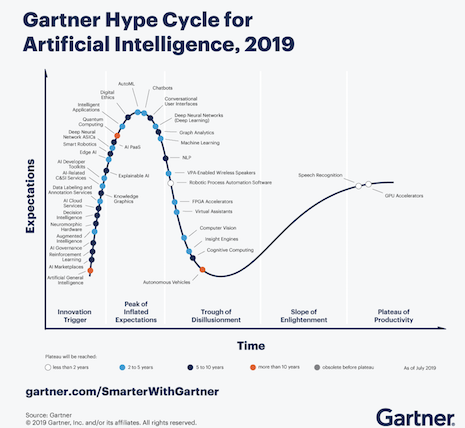
Gartner has identified the top 10 trends for data and analytics technology for 2020. Image credit: Gartner
By Dianna Dilworth
Digital channel adoption, which has been increasing recently, has accelerated over the last year thanks to the COVID-19 coronavirus pandemic.
To adapt to these evolving technological trends, Gartner has outlined 10 data and analytics trends for 2020 that can help marketers guide their post-COVID-19 response efforts.
“Business and society is becoming increasingly more digital, complex, global and interwoven, yet local, with ever-growing competition and emancipated customers," said Rita Sallam, research vice president at Gartner, Stamford, CT.
"Massive disruption, crisis and the ensuing economic downturn are forcing companies to respond to previously unimaginable customer demands to resource optimize, reinvent processes and rethink products, business models and even their very purpose," she said.
"Only resilient, nimble and creative organizations will survive and thrive. The combinatory power of more sophisticated and complex analytics, on a greater variety of data, has become more strategic and central to the creative thinking required to innovate our way beyond the post-COVID-19 world of global uncertainty and change."
AI, dashboards and decision intelligence
Artificial intelligence (AI) techniques, dashboards and decision intelligence are the first three trends that Gartner predicts in the coming years.
By the end of 2024, 75 percent of brands will shift from piloting AI to operationalizing it, according to a new report from Gartner. This represents a 5x increase in streaming data and analytics infrastructures.
AI techniques such as machine learning (ML), optimization and natural language processing (NLP) have helped with vital insights and predictions about the spread of the virus and the impact of countermeasures. This will be even more important moving forward.
By 2023, more than 33 percent of large organizations will have analysts practicing decision intelligence, which allows companies to create decision models and processes in the context of business outcomes and behavior.
Interestingly, in a post-COVID-19 world, the dashboard will phase out.
“Dynamic data stories with more automated and consumerized experiences will replace visual, point-and-click authoring and exploration,” per the report. “As a result, the amount of time users spend using predefined dashboards will decline.”
 Gartner's latest report looks at how the adoption of new technologies are evolving post-COVID-19. Image credit: Gartner
Gartner's latest report looks at how the adoption of new technologies are evolving post-COVID-19. Image credit: Gartner
X Analytics, augmented data management and the collision of data and analytics
Gartner uses the term “X analytics” to describe situations in which X is the data variable for a range of different structured and unstructured content including text analytics, video analytics and audio analytics.
These techniques will play an important role in identifying, predicting and planning in the future, according to Gartner's fourth prediction.
Augmented data management is the fifth trend in analytics predicted by Gartner, since it uses ML and AI techniques to optimize and improve operations. This process uses metadata for auditing, lineage and reporting.
The toolsets can look at large samples of operational data such as performance data and schemas to optimize marketing, security and performance.
A growth in cloud computing is Gartner’s sixth prediction. Ninety percent of data and analytics innovation will come from public cloud services by 2022.
There are challenges with processes when moving data and analytics to the cloud. Companies will have to balance cloud service costs against the performance requirements.
Data and analytics leaders should focus on how they can exploit cloud capabilities and cost optimization.
The seventh trend in the report is interesting: that the data and analytics worlds will collide.
Historically, each of these categories has been
distinct and managed separately. But currently vendors are creating end-to-end workflows enabled by augmented analytics that are blending these entities together.
As these two worlds meet, both the technology and the people that manage these processes will come together.
"
Engaging customers through digital channels is an imperative for most luxury brands," Ms. Sallam said.
"
Luxury brands will be under pressure to leverage the unique datasets they have, along with new AI techniques to continuously adapt to customer and market change.
"Reimagining established processes, digital products, customer experiences and business models will depend at an unprecedented pace with depend on building a data-centric, digital business," she said.
 Gartner's hype cycle for AI from 2019. Image credit: Gartner
Gartner's hype cycle for AI from 2019. Image credit: Gartner
Data marketplaces, blockchain and relationships
Gartner's eighth expectation is that data marketplaces and exchanges will consolidate.
By 2022, 35 percent of large organizations will be either sellers or buyers of data via formal online data marketplaces, up from 25 percent in 2020. These exchanges will allow companies to consolidate third-party data and will reduce costs for third-party data.
Blockchain will help address two challenges in data and analytics, according to Gartner's ninth prediction. Blockchain will give marketers the full lineage of assets and transactions and provide transparency for complex networks of participants.
Finally, Gartner anticipates that relationships will form the foundation of data and analytics value.
By 2023, thirty percent of companies will use graph technologies to facilitate rapid contextualization. Graph analytics allows brands to explore relationships between companies, consumers and transactions.
"It helps data and analytics leaders find unknown relationships in data and review data not easily analyzed with traditional analytics," the Gartner report said.
 Gartner has identified the top 10 trends for data and analytics technology for 2020. Image credit: Gartner
Gartner has identified the top 10 trends for data and analytics technology for 2020. Image credit: Gartner
 Gartner's latest report looks at how the adoption of new technologies are evolving post-COVID-19. Image credit: Gartner
Gartner's latest report looks at how the adoption of new technologies are evolving post-COVID-19. Image credit: Gartner Gartner's hype cycle for AI from 2019. Image credit: Gartner
Gartner's hype cycle for AI from 2019. Image credit: Gartner